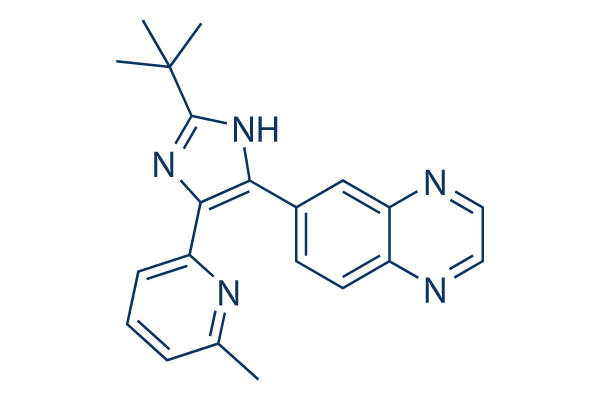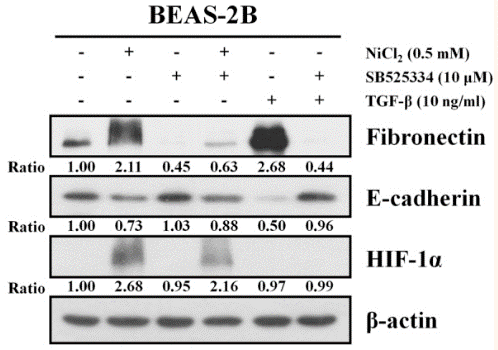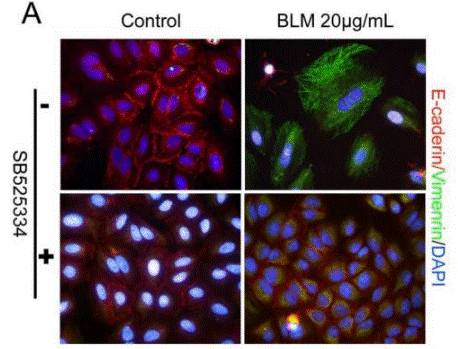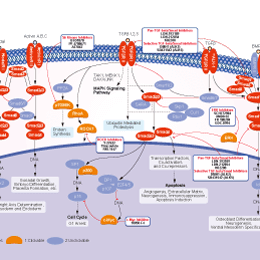
- Bioactive Compounds
- By Signaling Pathways
- PI3K/Akt/mTOR
- Epigenetics
- Methylation
- Immunology & Inflammation
- Protein Tyrosine Kinase
- Angiogenesis
- Apoptosis
- Autophagy
- ER stress & UPR
- JAK/STAT
- MAPK
- Cytoskeletal Signaling
- Cell Cycle
- TGF-beta/Smad
- Compound Libraries
- Popular Compound Libraries
- Customize Library
- Clinical and FDA-approved Related
- Bioactive Compound Libraries
- Inhibitor Related
- Natural Product Related
- Metabolism Related
- Cell Death Related
- By Signaling Pathway
- By Disease
- Anti-infection and Antiviral Related
- Neuronal and Immunology Related
- Fragment and Covalent Related
- FDA-approved Drug Library
- FDA-approved & Passed Phase I Drug Library
- Preclinical/Clinical Compound Library
- Bioactive Compound Library-I
- Bioactive Compound Library-Ⅱ
- Kinase Inhibitor Library
- Express-Pick Library
- Natural Product Library
- Human Endogenous Metabolite Compound Library
- Alkaloid Compound LibraryNew
- Angiogenesis Related compound Library
- Anti-Aging Compound Library
- Anti-alzheimer Disease Compound Library
- Antibiotics compound Library
- Anti-cancer Compound Library
- Anti-cancer Compound Library-Ⅱ
- Anti-cancer Metabolism Compound Library
- Anti-Cardiovascular Disease Compound Library
- Anti-diabetic Compound Library
- Anti-infection Compound Library
- Antioxidant Compound Library
- Anti-parasitic Compound Library
- Antiviral Compound Library
- Apoptosis Compound Library
- Autophagy Compound Library
- Calcium Channel Blocker LibraryNew
- Cambridge Cancer Compound Library
- Carbohydrate Metabolism Compound LibraryNew
- Cell Cycle compound library
- CNS-Penetrant Compound Library
- Covalent Inhibitor Library
- Cytokine Inhibitor LibraryNew
- Cytoskeletal Signaling Pathway Compound Library
- DNA Damage/DNA Repair compound Library
- Drug-like Compound Library
- Endoplasmic Reticulum Stress Compound Library
- Epigenetics Compound Library
- Exosome Secretion Related Compound LibraryNew
- FDA-approved Anticancer Drug LibraryNew
- Ferroptosis Compound Library
- Flavonoid Compound Library
- Fragment Library
- Glutamine Metabolism Compound Library
- Glycolysis Compound Library
- GPCR Compound Library
- Gut Microbial Metabolite Library
- HIF-1 Signaling Pathway Compound Library
- Highly Selective Inhibitor Library
- Histone modification compound library
- HTS Library for Drug Discovery
- Human Hormone Related Compound LibraryNew
- Human Transcription Factor Compound LibraryNew
- Immunology/Inflammation Compound Library
- Inhibitor Library
- Ion Channel Ligand Library
- JAK/STAT compound library
- Lipid Metabolism Compound LibraryNew
- Macrocyclic Compound Library
- MAPK Inhibitor Library
- Medicine Food Homology Compound Library
- Metabolism Compound Library
- Methylation Compound Library
- Mouse Metabolite Compound LibraryNew
- Natural Organic Compound Library
- Neuronal Signaling Compound Library
- NF-κB Signaling Compound Library
- Nucleoside Analogue Library
- Obesity Compound Library
- Oxidative Stress Compound LibraryNew
- Plant Extract Library
- Phenotypic Screening Library
- PI3K/Akt Inhibitor Library
- Protease Inhibitor Library
- Protein-protein Interaction Inhibitor Library
- Pyroptosis Compound Library
- Small Molecule Immuno-Oncology Compound Library
- Mitochondria-Targeted Compound LibraryNew
- Stem Cell Differentiation Compound LibraryNew
- Stem Cell Signaling Compound Library
- Natural Phenol Compound LibraryNew
- Natural Terpenoid Compound LibraryNew
- TGF-beta/Smad compound library
- Traditional Chinese Medicine Library
- Tyrosine Kinase Inhibitor Library
- Ubiquitination Compound Library
-
Cherry Picking
You can personalize your library with chemicals from within Selleck's inventory. Build the right library for your research endeavors by choosing from compounds in all of our available libraries.
Please contact us at [email protected] to customize your library.
You could select:
- Antibodies
- Bioreagents
- qPCR
- 2x SYBR Green qPCR Master Mix
- 2x SYBR Green qPCR Master Mix(Low ROX)
- 2x SYBR Green qPCR Master Mix(High ROX)
- Protein Assay
- Protein A/G Magnetic Beads for IP
- Anti-DYKDDDDK Tag magnetic beads
- Anti-DYKDDDDK Tag Affinity Gel
- Anti-Myc magnetic beads
- Anti-HA magnetic beads
- Poly DYKDDDDK Tag Peptide lyophilized powder
- Protease Inhibitor Cocktail
- Protease Inhibitor Cocktail (EDTA-Free, 100X in DMSO)
- Phosphatase Inhibitor Cocktail (2 Tubes, 100X)
- Cell Biology
- Cell Counting Kit-8 (CCK-8)
- Animal Experiment
- Mouse Direct PCR Kit (For Genotyping)
- New Products
- Contact Us
SB525334
SB525334 is a potent and selective inhibitor of TGFβ receptor I (ALK5) with IC50 of 14.3 nM in a cell-free assay, 4-fold less potent to ALK4 than ALK5 and inactive to ALK2, 3, and 6.

SB525334 Chemical Structure
CAS: 356559-20-1
Selleck's SB525334 has been cited by 98 publications
Purity & Quality Control
Batch:
Purity:
99.99%
99.99
Other TGF-beta/Smad Products
Related compound libraries
Choose Selective TGF-beta/Smad Inhibitors
Cell Data
| Cell Lines | Assay Type | Concentration | Incubation Time | Formulation | Activity Description | PMID |
|---|---|---|---|---|---|---|
| rhPOSTN | Apoptosis Assay | 0.5 μM | 48 h | significantly decreases the number of apoptotic cells | 24129188 | |
| HUVECs | Function Assay | 10 μM | 24/48/72 h | leads to a disruption of the HUVEC monolayer after 72 hr | 23968981 | |
| HUVECs | Function Assay | 10 μM | 72 h | blocks signaling | 23968981 | |
| HUVECs | Function Assay | 10 μM | 72 h | reduces the phosphorylation of smad2 | 23968981 | |
| MiaPaCa2 | Cell Viability Assay | 0-10 μM | 72 h | efficiently reduces the viability with gemcitabine | 22399597 | |
| AsPC1 | Cell Viability Assay | 0-10 μM | 72 h | efficiently reduces the viability with gemcitabine | 22399597 | |
| PASMCs | Function Assay | 1 μM | 15 min | inhibits TGF-β1-mediated proliferation of familial iPAH PASMCs at an IC50 of 295 nmol/L | 19116361 | |
| ELT-3 | Function Assay | 0.5/1.0/2.0 μM | 1 h | DMSO | inhibits TGF-β signaling in leiomyomas | 17505012 |
| Sf9 | Function assay | Inhibition of human recombinant GST-fused ALK5 expressed in Sf9 cells, IC50 = 0.162 μM. | 20472445 | |||
| TC32 | qHTS assay | qHTS of pediatric cancer cell lines to identify multiple opportunities for drug repurposing: Primary screen for TC32 cells | 29435139 | |||
| A673 | qHTS assay | qHTS of pediatric cancer cell lines to identify multiple opportunities for drug repurposing: Primary screen for A673 cells | 29435139 | |||
| Saos-2 | qHTS assay | qHTS of pediatric cancer cell lines to identify multiple opportunities for drug repurposing: Primary screen for Saos-2 cells | 29435139 | |||
| BT-37 | qHTS assay | qHTS of pediatric cancer cell lines to identify multiple opportunities for drug repurposing: Primary screen for BT-37 cells | 29435139 | |||
| BT-12 | qHTS assay | qHTS of pediatric cancer cell lines to identify multiple opportunities for drug repurposing: Primary screen for BT-12 cells | 29435139 | |||
| NB1643 | qHTS assay | qHTS of pediatric cancer cell lines to identify multiple opportunities for drug repurposing: Primary screen for NB1643 cells | 29435139 | |||
| OHS-50 | qHTS assay | qHTS of pediatric cancer cell lines to identify multiple opportunities for drug repurposing: Primary screen for OHS-50 cells | 29435139 | |||
| Rh41 | qHTS assay | qHTS of pediatric cancer cell lines to identify multiple opportunities for drug repurposing: Primary screen for Rh41 cells | 29435139 | |||
| SJ-GBM2 | qHTS assay | qHTS of pediatric cancer cell lines to identify multiple opportunities for drug repurposing: Primary screen for SJ-GBM2 cells | 29435139 | |||
| SK-N-MC | qHTS assay | qHTS of pediatric cancer cell lines to identify multiple opportunities for drug repurposing: Primary screen for SK-N-MC cells | 29435139 | |||
| Click to View More Cell Line Experimental Data | ||||||
Biological Activity
| Description | SB525334 is a potent and selective inhibitor of TGFβ receptor I (ALK5) with IC50 of 14.3 nM in a cell-free assay, 4-fold less potent to ALK4 than ALK5 and inactive to ALK2, 3, and 6. | ||
|---|---|---|---|
| Targets |
|
| In vitro | ||||
| In vitro | SB 525334 shows no inhibition in the enzymes ALK2, 3, and 6, with IC50 values > 10 μM. SB 525334 blocks phosphorylation induced by TGF-β1 and nuclear translocation of Smad2/3 in renal proximal tubule cells. SB 525334 also inhibits the increased mRNA expression levels of plasminogen activator inhibitor-1 (PAI-1) and procollagen α1(I) induced by TGF-β1 in A498 renal epithelial carcinoma cells at 1 μM). [1] SB 525334 (1 μM) attenuates the heightened sensitivity to TGF-β1 exhibited by pulmonary artery smooth muscle cells (PASMCs) from patients with familial forms of idiopathic pulmonary arterial hypertension (PAH). [2] | |||
|---|---|---|---|---|
| Kinase Assay | Kinase assay to determine the potency and selectivity of SB 525334 | |||
| In order to determine the potency of SB 525334, purified GST-tagged kinase domain of ALK5 is incubated with purified GST-tagged full-length Smad3 in the presence of 33P-γATP and different concentrations of SB 525334. The readout is radioactively labeled Smad3. To determine the selectivity of SB 525334, purified GST-tagged kinase domain of ALK2 and ALK4 are incubated with GST-tagged full-length Smad1 and Smad3, respectively, in the presence of different concentrations of SB 525334. IC50 values are calculated. | ||||
| Cell Research | Cell lines | Human renal proximal tubule epithelial (RPTE) cells | ||
| Concentrations | 1 μM | |||
| Incubation Time | 1 hour | |||
| Method | RPTE cells are seeded on microscope slides. The following day, the cells are starved for 24 hours to dosing by removal of the serum and epidermal growth factor. Cells are treated with either 10 ng/mL TGF-β1, 1 μM SB 525334, or a combination of both. Slides are pretreated with SB 525334 or starve media for 3 hours prior to a 1-hour incubation at 37 °C with TGF-β1 or starve media. The cells are then fixed and permeabilized. The slides are blocked with BSA, incubated with a mouse anti-Smad2/3 primary antibody followed by an anti-mouse IgG fluorescein secondary antibody. The slides are then viewed in a confocal microscope and nuclear signal intensity is analyzed. | |||
| Experimental Result Images | Methods | Biomarkers | Images | PMID |
| Western blot | Fibronectin / E-cadherin / Hif-1α |

|
29127306 | |
| Immunofluorescence | E-cadherin / Vimentin |

|
27471572 | |
| In Vivo | ||
| In vivo | SB 525334 (10 mg/kg/day) decreases the renal mRNA levels of PAI-1, procollagen α1(I), and procollagen α1(III) in a nephritis-induced renal fibrosis rat model. Furthermore, PAN-induced proteinuria is significantly inhibited by SB 525334 (10 mg/kg/day). [1] SB 525334 may also be efficacious in mesenchymal tumors. SB 525334 (10 mg/kg/day) significantly decreases uterine mesenchymal tumor incidence, multiplicity, and size in Eker rats. [3] SB 525334 significantly reverses pulmonary arterial pressure and inhibits right ventricular hypertrophy in a rat model of PAH. This is revealed by a significant reduction in pulmonary arteriole muscularization induced by monocrotaline (used to induce PAH) after treatment with SB 525334 (3 or 30 mg/kg). [2] In a Bleomycin-induced pulmonary fibrosis mice model, SB 525334 (10 mg/kg or 30 mg/kg) attenuates the histopathological alterations in the lung, and significantly decreased mRNA expression of Type I and III procollagen and fibronectin. SB 525334 also attenuates Smad2/3 nuclear translocation, myofibroblast proliferation, deposition of Type I collagen, and decreases CTGF-expressing cells. [4] | |
|---|---|---|
| Animal Research | Animal Models | Bleomycin-induced pulmonary fibrosis in female Eker rats |
| Dosages | Estimated dose of 10 mg/kg/day | |
| Administration | Oral (in drinking water) | |
Chemical lnformation & Solubility
| Molecular Weight | 343.42 | Formula | C21H21N5 |
| CAS No. | 356559-20-1 | SDF | Download SB525334 SDF |
| Smiles | CC1=NC(=CC=C1)C2=C(N=C(N2)C(C)(C)C)C3=CC4=NC=CN=C4C=C3 | ||
| Storage (From the date of receipt) | |||
|
In vitro |
DMSO : 69 mg/mL ( (200.92 mM); Moisture-absorbing DMSO reduces solubility. Please use fresh DMSO.) Ethanol : 69 mg/mL Water : Insoluble |
Molecular Weight Calculator |
|
In vivo Add solvents to the product individually and in order. |
In vivo Formulation Calculator |
||||
Preparing Stock Solutions
Molarity Calculator
In vivo Formulation Calculator (Clear solution)
Step 1: Enter information below (Recommended: An additional animal making an allowance for loss during the experiment)
mg/kg
g
μL
Step 2: Enter the in vivo formulation (This is only the calculator, not formulation. Please contact us first if there is no in vivo formulation at the solubility Section.)
% DMSO
%
% Tween 80
% ddH2O
%DMSO
%
Calculation results:
Working concentration: mg/ml;
Method for preparing DMSO master liquid: mg drug pre-dissolved in μL DMSO ( Master liquid concentration mg/mL, Please contact us first if the concentration exceeds the DMSO solubility of the batch of drug. )
Method for preparing in vivo formulation: Take μL DMSO master liquid, next addμL PEG300, mix and clarify, next addμL Tween 80, mix and clarify, next add μL ddH2O, mix and clarify.
Method for preparing in vivo formulation: Take μL DMSO master liquid, next add μL Corn oil, mix and clarify.
Note: 1. Please make sure the liquid is clear before adding the next solvent.
2. Be sure to add the solvent(s) in order. You must ensure that the solution obtained, in the previous addition, is a clear solution before proceeding to add the next solvent. Physical methods such
as vortex, ultrasound or hot water bath can be used to aid dissolving.
Tech Support
Answers to questions you may have can be found in the inhibitor handling instructions. Topics include how to prepare stock solutions, how to store inhibitors, and issues that need special attention for cell-based assays and animal experiments.
Tel: +1-832-582-8158 Ext:3
If you have any other enquiries, please leave a message.
* Indicates a Required Field
Frequently Asked Questions
Question 1:
I want to know the feasibility of using the compound via oral gavage in rodents (dosing, frequency, formulation…)?
Answer:
Our S1476 can be used for oral gavage in rodents, and the vehicle we suggest is: 30% Propylene glycol, 5% Tween 80, 65% D5W (dextrose(5%)in water) at 20mg/ml maximum. Based on the following reference they administrated it at an estimated dose of 10 mg/kg/day in rat for 2 months: http://clincancerres.aacrjournals.org/content/13/10/3087.long
Tags: buy SB525334 | SB525334 supplier | purchase SB525334 | SB525334 cost | SB525334 manufacturer | order SB525334 | SB525334 distributor








































